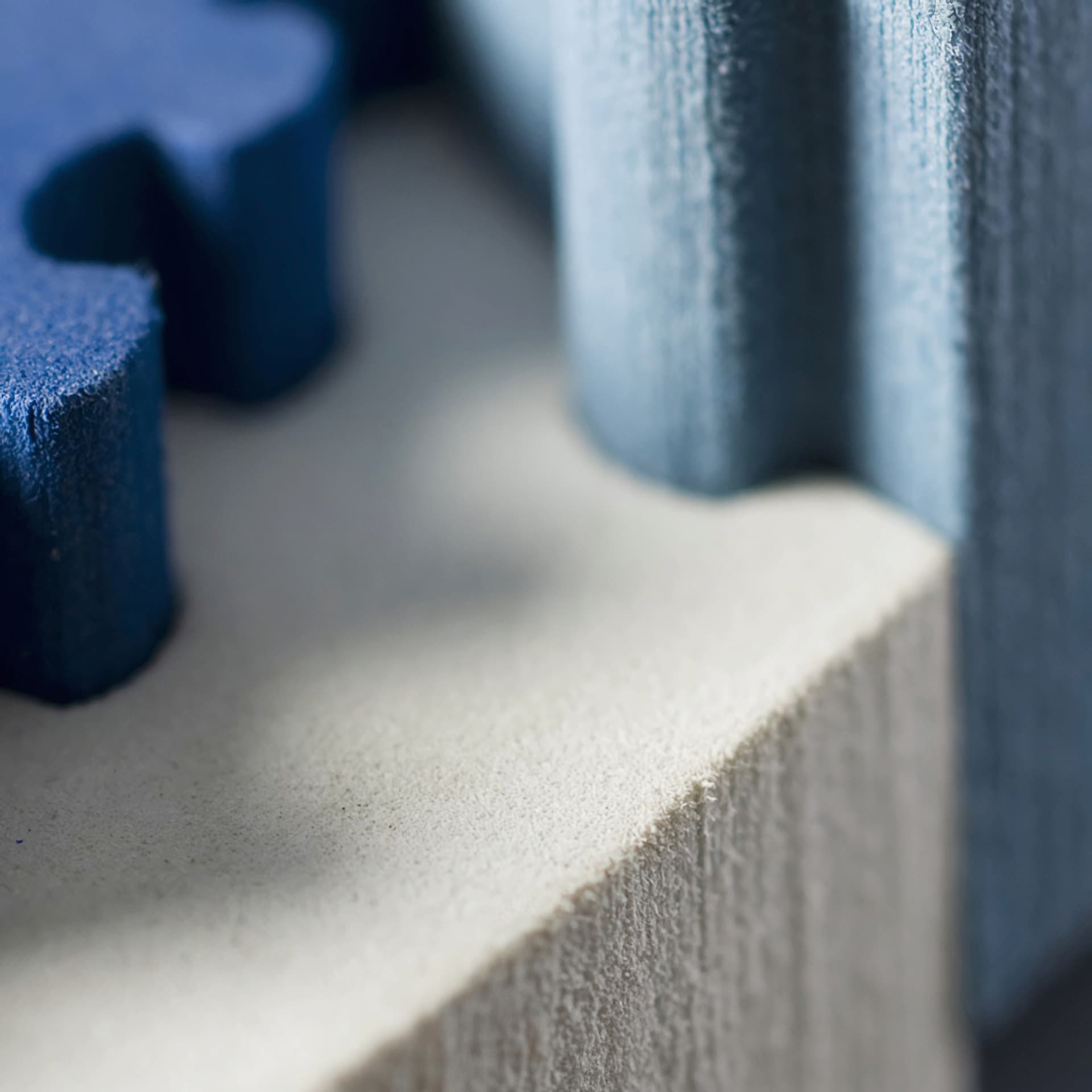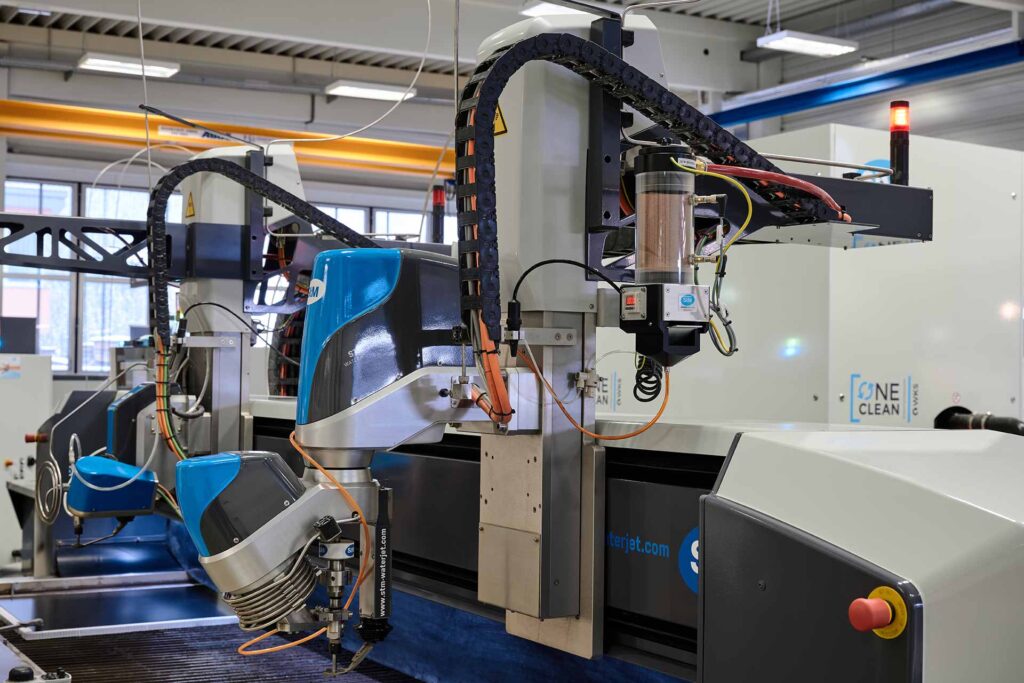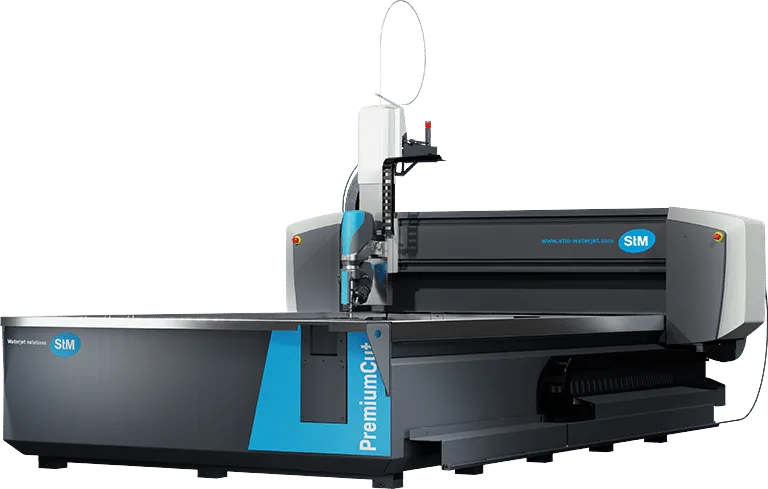Waterjet Cutting Foam
Polyurethane foam (PUR), polystyrene foam (EPS), PVC foam and many more.
Waterjet cutting is a fascinating technology that has also proven to be extremely effective and versatile in the field of foam processing. With this method, foams can be cut precisely and with exceptional accuracy, without deformation or material damage.
Particularly impressive in waterjet cutting of foams is the precision. Even complex shapes and fine details can be realized effortlessly, making it an ideal solution for customized foam parts. The water jet cuts without generating any heat, which means that the foam does not heat up or melt during the process. This feature allows cutting of delicate foams or those with low melting points without compromising material integrity.
Last but not least, the versatility of waterjet cutting of foams is worth mentioning. Even layers with different densities can be cut simultaneously, increasing efficiency and reducing production time. The process is very environmentally friendly, as no harmful fumes or chemicals are produced.
Table of contents
Table of contents
What types of foam can be cut?
Waterjet cutting opens up a versatile solution for the precise processing of a wide variety of foams.
Among the many species suitable for this method are polyurethane foams, which are used in upholstered furniture, mattresses and insulation materials due to their variable density and hardness. Polystyrene foam, better known as Styrofoam, is also very suitable and is often used in packaging, building insulation and model making due to its low weight and high insulating properties. PVC foams are also successfully processed with waterjet cutting and are popular for construction applications, signage, and boat manufacturing and buoyancy aids due to their flexibility, lightness, and resistance to moisture and chemicals.
Thanks to its precision and gentle on materials, waterjet cutting is the preferred method for processing foams in a wide range of industries.
- Polyurethane foam (PUR)
- Polystyrene foam (EPS)
- Polyethylene foam (PE)
- EVA foam (ethylene vinyl acetate)
- PVC foam
- Rebond foam
- Memory foam
- Neoprene foam
Would you like more information about cutting foam with water?
5 advantages – waterjet cutting foam
Waterjet cutting of foams offers a variety of advantages that make it an optimal processing method for this material. Precise cutting is one of the most outstanding aspects, as it enables complex shapes and detailed patterns to be precisely implemented in foams. This accuracy is particularly advantageous when producing custom foam parts for various applications.
Another major advantage of waterjet cutting is the cold cutting technique, which ensures that no heat is generated during the cutting process. This minimizes the risk of melting or deforming sensitive foams and enables gentle machining. This is particularly important when processing thin or thermally sensitive foams.
The variety of materials offered by waterjet cutting is another plus. It can handle a wide range of foam types, including polyurethane, polystyrene, PVC foam and more. In addition, the waterjet leaves clean cut edges without fraying or burrs, often eliminating the need for additional finishing. This saves time and resources and significantly increases productivity.
Last but not least, waterjet cutting is also environmentally friendly. This makes waterjet cutting a sustainable and environmentally conscious alternative to other cutting processes that could potentially produce harmful emissions.
Technical details
Waterjet cutting of foams is based on advanced technology specifically tailored to the requirements of this material. A powerful jet of water is generated under high pressure and directed through a fine nozzle. By adding abrasive particles to the water jet, the cutting performance is enhanced, making it possible to process even robust foams with high precision.
Waterjet cutting of foams requires special cutting tables and fixtures to securely hold the material in place and minimize vibration during the cutting process. The waterjet machine is controlled by computerized programs that specify exact cutting patterns and shapes. By adjusting the cutting pressure, speed and abrasive quantity, the accuracy and quality of cutting can be optimized.
The combination of technical precision, versatile adjustment options and gentle material processing makes waterjet cutting an extremely effective method for high-quality, customized processing of foams in various industries. Modern waterjet cutting systems from STM offer a wide range of fine-tuning options and guarantee the highest precision and quality when cutting plastic.
For thinner foams, such as polystyrene or EVA foam, material thicknesses of about 1 mm to 10 mm can be processed well. With thicker foams, such as polyurethane or PVC foam, material thicknesses of 10 mm to 100 mm and more are possible.
Any shape cuts and bevel cuts up to 60° are possible.
The cutting accuracy is usually +/- 0.1 mm.
In waterjet cutting, the cut quality is basically divided into 5 quality levels.
- Separating cut Q1 (for blanks / semi-finished products)
- Standard cut Q3 (the most common cut)
- Fine cut Q5 (for optimum dimensional accuracy)
For waterjet cutting of foams, the achievable cutting speeds are usually in the range of 1000 to 4000 mm per minute.
As a rule, the water pressure for cutting foam is between 2000 and 4000 bar.
CNC control enables precise and repeatable cutting. The STM SmartCut cutting software offers high ease of use and functionality as well as flexibility.
References
The best advertising is known to be satisfied customers
Among our references you will find customers & partners from various fields. Among them are companies and facilities from the following industries:
- Metal industry
- Stone / Ceramics / Glass
- Plastics / foam industry
- Sealing industry
- Prototype / plant engineering
- Microwaterjet
- Educational Institutions
- Research
- Special materials
STM Product Finder
Find your work system – tailored to you
The individual wishes and requirements of our customers are the measure of all things for us. In order to be able to offer customized solutions for every requirement, we have developed a special product finder.
You tell us what you need to deliver perfect work and we put together the individual components and parts, as well as the associated software perfectly and individually. And if you are unsure, let your work material try our test cut.
FAQ – Frequently asked questions
The most frequently asked questions about waterjet cutting of foams
We have collected some FAQ on the topic, waterjet cutting of foam, and answered them succinctly for you.
If your question is not answered, please feel free to contact us directly.
Is waterjet cutting suitable for sensitive foams?
Yes, waterjet cutting is ideal for delicate foams because there is no heat exposure to damage the material.
Can waterjet cutting cut complex shapes from foams?
Yes, waterjet cutting can precisely cut complex shapes and fine details in various foams.
What types of foam can be processed with waterjet cutting?
Waterjet cutting is suitable for a wide range of foams, including polyurethane, polystyrene, PVC foam.
Are the cut edges of foams clean and burr-free during waterjet cutting?
Yes, waterjet cutting leaves clean cut edges without fraying or burrs when cutting foam.
What material thicknesses can be processed in waterjet cutting of foams?
As a rule, material thicknesses from a few millimeters to several centimeters can be processed.
Is waterjet cutting environmentally friendly for foam processing?
Yes, waterjet cutting is environmentally friendly because it produces no harmful fumes or dust particles .
What is the required water pressure for waterjet cutting of foams?
The required water pressure is usually between 2000 and 4000 bar, depending on the type and density of the foam.
How much water do I need for waterjet cutting foam?
As a rule, about 3 liters of water are needed in one minute for waterjet cutting of foams. This depends on the type and material thickness of the foam, as well as other adjustment options.


